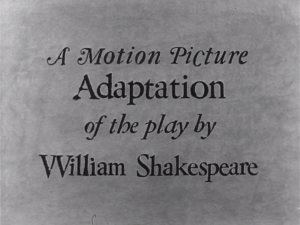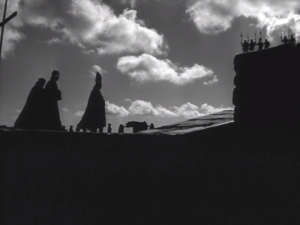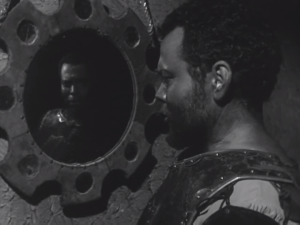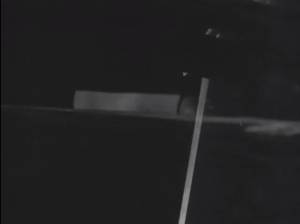 Welles Week: Part Two of Five
Welles Week: Part Two of Five
The Tragedy of Othello: The Moor of Venice | Orson Welles | USA, Italy, Morocco, France | 1952 | 92 min
UW Cinematheque, 4070 Vilas Hall, Saturday February 7, 7:00pm»
While Welles’ adaptation may break a few of the play’s structural bones, its heart is more than intact, with a vitality created principally by the film’s cinematography, its score, and its editing.
Two things struck me as I revisited Welles’ Othello. First, I thought about Kenneth Branagh’s Hamlet, claiming to be a complete presentation of the source play. While I enjoy that film tremendously, there is something to be said for an adaptation that cuts some of the source material’s scenes, so as to cut to the heart of the work. Othello certainly does that. Second, I was reminded of a common complaint toward some films: “There were a lot of scenes that worked on their own, but they didn’t come together.” Made over three years, with several breaks in production and Welles hard-up for financing, Othello‘s scenes most certainly do come together, almost astonishingly so. On the surface, it may look like a bit of a mess, but it’s the mess of a master.
 From the very first shot, even though the titles reinforce that this is “A Motion Picture Adaptation,” Welles refuses to start with Act I, Scene 1, instead beginning with the tale’s end. Along with several other touches, such as the later mirror shots of Othello, the framing device of the funeral procession hearkens back to Citizen Kane. While it lacks Kane’s polish, the opening sequence’s canted angles, aperture framing, and elaborate multi-planar staging serve as stylistic prelude, all decidedly emphasizing the words “motion picture” in the phrase above. Despite having five credited cinematographers, Othello has a remarkable visual consistency. With its combination of canted angles and characters constantly changing positions—one lower than the other, then higher, then both squeezed together in frame, then out again—it’s as if the film rests on a kind of unsteady axis, which combines with other elements to lend the film a feverish feel. It’s that atmosphere that bolsters the sinister jealousy with which Iago fills Othello’s mind, and it’s that atmosphere that lends the film its most important fidelity: that to the spirit of the source material.
From the very first shot, even though the titles reinforce that this is “A Motion Picture Adaptation,” Welles refuses to start with Act I, Scene 1, instead beginning with the tale’s end. Along with several other touches, such as the later mirror shots of Othello, the framing device of the funeral procession hearkens back to Citizen Kane. While it lacks Kane’s polish, the opening sequence’s canted angles, aperture framing, and elaborate multi-planar staging serve as stylistic prelude, all decidedly emphasizing the words “motion picture” in the phrase above. Despite having five credited cinematographers, Othello has a remarkable visual consistency. With its combination of canted angles and characters constantly changing positions—one lower than the other, then higher, then both squeezed together in frame, then out again—it’s as if the film rests on a kind of unsteady axis, which combines with other elements to lend the film a feverish feel. It’s that atmosphere that bolsters the sinister jealousy with which Iago fills Othello’s mind, and it’s that atmosphere that lends the film its most important fidelity: that to the spirit of the source material.
 Admittedly, there are scenes where it is easier to tell that their constituent shots were not captured on the same day, or perhaps even in the same year. The audience’s sense of space can go from merely confusing to truly dizzying, especially in the way large crowds can sometimes appear from absolutely nowhere with effortless speed. In addition, Welles gives voice not just to Othello (both onscreen and in voiceover) but to an unseen narrator who relays initial background information (again in voiceover), and is then summarily dropped for the rest of the film. And if the voice of Roderigo sounds remarkably like Welles, that’s because it is Welles’ voice. All of these disorganized elements—along with four credited editors—converge to form a product that should be a train wreck, but is instead far more dynamic than its counterparts of the time.
Admittedly, there are scenes where it is easier to tell that their constituent shots were not captured on the same day, or perhaps even in the same year. The audience’s sense of space can go from merely confusing to truly dizzying, especially in the way large crowds can sometimes appear from absolutely nowhere with effortless speed. In addition, Welles gives voice not just to Othello (both onscreen and in voiceover) but to an unseen narrator who relays initial background information (again in voiceover), and is then summarily dropped for the rest of the film. And if the voice of Roderigo sounds remarkably like Welles, that’s because it is Welles’ voice. All of these disorganized elements—along with four credited editors—converge to form a product that should be a train wreck, but is instead far more dynamic than its counterparts of the time.
 Two scenes stand out in this regard. First, look at the killing of Roderigo. Sure, there is the trivia of the scene being shot in a Turkish bath due to the costumes being confiscated for lack of payment. More interesting is how Welles constructs this scene, with Iago slowly creeping up above Roderigo, who is sheltered under the floor of the bathhouse and calls out to him. We get a disturbing closeup of Iago’s murderous gaze, and then an almost avant-garde set of superimpositions of Iago’s blade stabbing through the floor on opposite sides of the screen and the camera spinning wildly in an arresting set of dissolves. The style supplies the violence in a more jarring way than seeing the blade pierce flesh. Second, by way of a sort of negative example, take a look at the long take dolly shot where Othello and Iago (played “excellent well” by Micheál MacLiammóir) walk along the battlements in Cyprus, when Iago talks about the “green-eyed monster” that is jealousy. There is a sense of editorial calm here that is absent in much of the film. Not long after, we are presented with a bizarre set of point-of-view shots between Othello and Desdemona, and we are returned to the chaos from which we had taken respite. If this film were a hurricane, that battlement scene would surely be its eye.
Two scenes stand out in this regard. First, look at the killing of Roderigo. Sure, there is the trivia of the scene being shot in a Turkish bath due to the costumes being confiscated for lack of payment. More interesting is how Welles constructs this scene, with Iago slowly creeping up above Roderigo, who is sheltered under the floor of the bathhouse and calls out to him. We get a disturbing closeup of Iago’s murderous gaze, and then an almost avant-garde set of superimpositions of Iago’s blade stabbing through the floor on opposite sides of the screen and the camera spinning wildly in an arresting set of dissolves. The style supplies the violence in a more jarring way than seeing the blade pierce flesh. Second, by way of a sort of negative example, take a look at the long take dolly shot where Othello and Iago (played “excellent well” by Micheál MacLiammóir) walk along the battlements in Cyprus, when Iago talks about the “green-eyed monster” that is jealousy. There is a sense of editorial calm here that is absent in much of the film. Not long after, we are presented with a bizarre set of point-of-view shots between Othello and Desdemona, and we are returned to the chaos from which we had taken respite. If this film were a hurricane, that battlement scene would surely be its eye.
As Jim mentioned in his post yesterday, Othello is rather difficult to see. The DVD has been out of print for some time, though hopefully we’ll see a rerelease and restoration in the not-too-distant future. With all of this in mind, I will be looking forward to the February 7 screening immensely. More than the picture, I’m particularly looking forward to the sound, as the film has a score that is unforgettably troubling. Othello, perhaps more than most of Welles’ work, is a film that needs the right presentation, something of which the good people at Cinematheque are thankfully masters themselves.
Before he takes his own life, Othello says, “When you shall these unlucky deeds relate, speak of me as I am. Nothing extenuate, nor set down aught in malice.” It’s hard not to read into this, with respect both to the misfortunes of this film’s production history as well as Welles’ later years. Thus, I speak of the film as it is: while the misfortunes of the its production are certainly extenuation, even with its flaws, it would be a mistake to think it’s a film that needs exoneration. Creativity can flourish under constraint, and Othello is certainly the “ocular proof” of that old adage.